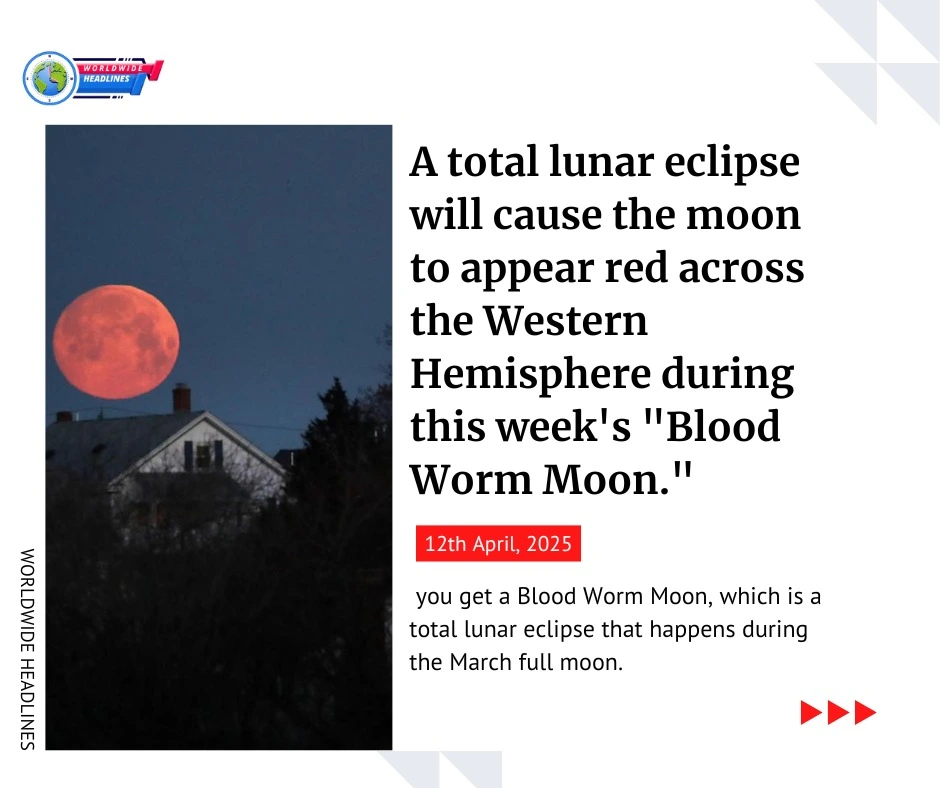On the night of March 13-14, 2025, millions of skywatchers across the Western Hemisphere witnessed an awe-inspiring celestial event—the rare Blood Moon. As Earth’s shadow swallowed the full Worm Moon, the night sky was bathed in an eerie, crimson glow, leaving spectators in awe.
Total lunar eclipse will cause the moon to appear red
This total lunar eclipse, the first of its kind since November 2022, was visible from North and South America to parts of Europe and Africa, delivering a truly unforgettable sight.
Why Is It Called the Blood Worm Moon?
March’s full moon, traditionally called the Worm Moon, signals the arrival of spring as thawing ground awakens earthworms, which in turn bring birds back to feast. But this year, the Worm Moon came with a dramatic twist.
During a total lunar eclipse, the Earth aligns perfectly between the Sun and the Moon, blocking direct sunlight.
However, instead of vanishing into darkness, the Moon turns a deep red as the Earth’s atmosphere filters and scatters shorter blue wavelengths, allowing only longer red hues to reach the lunar surface. The result? A spectacular Blood Moon that sent chills down the spines of stargazers worldwide.
How Long Did the Eclipse Last?
For a breathtaking one hour and six minutes, from 2:26 a.m. to 3:32 a.m. Eastern Time, the Blood Moon dominated the night sky.
The total eclipse unfolded gradually, allowing viewers to see the moon dim, darken, and finally transform into a stunning, rust-colored orb. While visibility depended on local weather conditions, lucky observers got to witness one of the most striking astronomical events of the year.
Stunning Photos Capture the Magic
In Mexico City, photographers snapped dazzling images of the moon’s fiery glow against the urban skyline, creating a surreal contrast between the natural and man-made worlds.
In Palm Springs, California, the Blood Moon was seen rising dramatically above the famous “Forever Marilyn” statue, offering a truly picture-perfect moment. Across social media, jaw-dropping images poured in from around the globe, capturing the beauty of the eclipse from different vantage points.
Not Everyone Got to See the Show
While many marveled at the celestial wonder, others weren’t so lucky. In Ireland, eager skywatchers stayed up late, only to be met with thick cloud cover obscuring the moon entirely.
Frustrated stargazers took to social media to express their disappointment, with some humorously lamenting, “Stayed up for the Blood Moon, got a Gray Cloud Moon instead.”
Missed It? Here’s When You Can See the Next One
If you missed this rare phenomenon, don’t worry—the cosmos always has more in store.
The next total lunar eclipse is set to occur in March 2026, offering another chance to witness the moon turn red.
Though these events are rare, they serve as mesmerizing reminders of the cosmic ballet that unfolds above us, inspiring wonder and curiosity about the vast universe we call home.
A Night to Remember
Whether seen firsthand or through the lenses of talented photographers, the March 2025 Blood Worm Moon was an astronomical marvel for the ages.
It proved once again that even in an era of digital screens and artificial wonders, nature’s grandest displays still hold the power to captivate, astonish, and remind us of our place in the universe. For now, we look to the skies in anticipation of the next cosmic spectacle.










